Publication Information
Frequency: Continuous
Format: PDF and HTML
Versions: Online (Open Access)
Year first Published: 2019
Language: English
| Journal Menu |
| Editorial Board |
| Reviewer Board |
| Articles |
| Open Access |
| Special Issue Proposals |
| Guidelines for Authors |
| Guidelines for Editors |
| Guidelines for Reviewers |
| Membership |
| Fee and Guidelines |
 |
Impact of Wool Pellet Fertilizer on Mongolian Gobi Soil
Orkhontuya Puntsag, Oyunchimeg Y doctor candidate, Javkhlnatuya Altansuvd1*
1Mongolian State University of Life Sciences, Ulaanbaatar, Mongolia
Received Date: August 04, 2022; Accepted Date: August 24, 2022; Published Date: September 03, 2022;
*Corresponding author: Javkhlnatuya Altansuvd. Mongolian State University of Life Sciences, Ulaanbaatar, Mongolia. Email: javkhlantuya_nart@muls.edu.mn
Citation: Puntsag O, Oyunchimeg Y, Altansuvd J (2022) Impact of Wool Pellet Fertilizer on Mongolian Gobi Soil. Adv Agri Horti and Ento: AAHE-174.
DOI: 10.37722/AAHAE.2022203
Introduction|
WHAT IS Mongolian wool PELLETS?
- High-quality organic fertilizer made of 100% Mongolian sheep wool
- Nutrient-rich with 10% Nitrogen (N) and 5% Potassium (K2O)
- Slow-release fertilizer with long-term effect of 10 months
- Natural water storage - capable of storing water 3.5 times of its own weight
- Humus formation and soil loosening through swell effect
- Natural and optimal regulation of nutrient and water supply to the plant (avoiding overfertilization)
- 100% regenerative without any extraneous additives or chemicals
- Approved for organic farming-ecological, sustainable and environmentally friendly
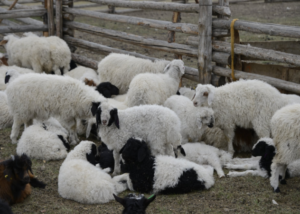
Selected properties of sheep wool wastes
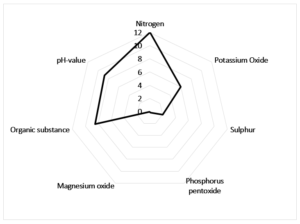
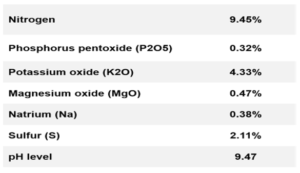
Wool pellets is made out of 100% Mongolian sheep wool and is a premium organic fertilizer with high nitrogen and potassium. Nitrogen is an essential component of proteins and is a characteristic element of plant cells (cytoplasm). A high nitrogen content enhances plant growth and development of green mass. Potassium fosters swelling and pressure in the plant cells. It also regulates the water balance and reduces evaporation. The pH-value shows that Mongolian sheep wool is an alkaline fertilizer, which prevents acidification of the soil.
Propose
Organic fertilizers made from Mongolian sheep's wool have been tested in mining biological rehabilitation to determine the appropriate dose rate to improve the growth of perennials and the fertility of sandy soils.
- To study the effects of sheep wool organic fertilizer for mine biological rehabilitation
- To determine the effect of sheep wool fertilizer on soil and plant properties
- To determine The dose of organic wool fertilizer should be compared with that of mineral wool
Innovative Aspects of Research and Practical Importance
For the first time in Mongolia, we are developing a technology to test organic fertilizer made from 100% sheep wool for biological rehabilitation of mines and efficiently recycling wool waste.
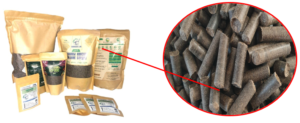
Figure 1: Packaged sheep wool fertilizer.
Selected properties of sheep wool wastes
рН
Salt, %
Moisture, %
Organic, %
Mineral, %
S, %
NO3 –N mg/kg
Total %
N
P2O5
K2O
8.89
0.249
5.68
44.6
55.4
2
131
9.64
0.56
4.8
Specifications
Standard for analysis
Detection
Total number of bacteria (1g/mln)
MNS 6341:2012
Undetected
E. coli titer
MNS 5367:2004
Undetected
Anaerobic titer (Cl.perferengens)
MNS 4694:1998
Undetected
Heavy metals, mg/kg
Detection
Acceptable amount
Harmful
Hazardous
Copper, Cu
0.073
< 100
>500
>1000
Zinc, Zn
16.7
< 300
>600
>1000
Chrome, Cr
-
< 150
>400
>1500
Cobalt, Co
-
< 50
>500
>1000
Nickel, Ni
39
< 150
>1000
>1800
Lead, Pb
3.3
< 100
>500
>1200
Methods and data collection
Erdenes Silver Resource LLC's “Salkhit Gold and Silver Deposit” mine located in Gurvansaikhan soum, Dundgovi aimag, Mongolia was tested with sheep wool fertilizer in 6 variants and 3 iterations. Primary natural recording and soil field recording were performed prior to the experiment, and 150 soil samples were collected prior to the start of the experiment and three soil measurements were made from each experimental variant 2020 to 2022.

Result and discussion
Initial soil characteristics (0–20 cm) of soils used in the field experiments (Table 5).
It is statistically probable that the soils of the three sites selected for the experiment did not differ in chemical baseline (P = <1.000).
Correlation between fertilizers applied in the experiment

The content of organic matter increases statistically depending on the doseage of wool fertilizer.
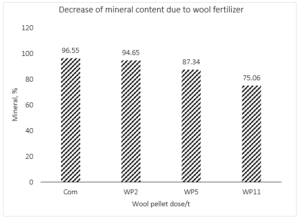
Depending on the dose of wool fertilizer, the content of minerals against organic matter decreases.
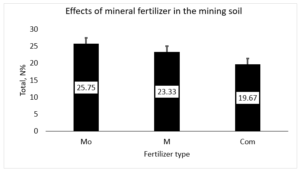
Wool fertilizers have a better effect on soil fertility than mineral fertilizers R=0.9 P<0.005.


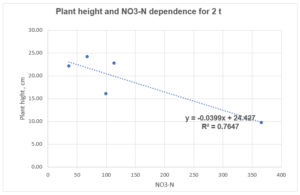
Soil moisture changes

In terms of field moisture, the moisture content increased statistically significantly in July-September, specifically by 11 ton and 5 ton variations (f = 5.1, p <0.0001) (Graph 1). Soil moisture content was not significantly affected by mineral fertilizer alone or the P-K fertilizer option.
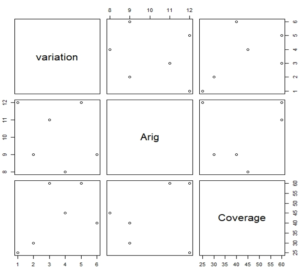
> P=0.0001
> TukeyHSD (model) - харьцуулхад 95% магдлал итгэлцэлтэй
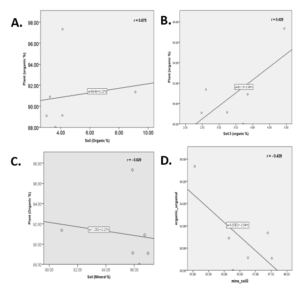
Conclusion
- In our study, when 2 tons, 5 tons, and 11 tons of wool fertilizers were applied for biological rehabilitation in mining sites, both soil nutrient parameters and plant growth were statistically significant p <0.0001. (It is economical to fertilize wool with 2 tons of fertilizer).
- The vegetation cover of our experimental area was less than 1 percent before the experiment, but as a result of our study, the vegetation cover increased to 50-60 percent and the plant species increased by 40 percent compared to the natural condition.
- In biological rehabilitation of mining sites, wool fertilizers were more effective than mineral fertilizers.